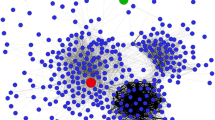Abstract
Amazon sales-rank gives a relative estimate of a product item’s popularity among other items in the same category. An early prediction of the Amazon sales-rank of a product would imply an early guess of its sales-popularity relative to the other products on Amazon, which is one of the largest e-commerce hub across the globe. Traditional methods suggest use of product review related features, e.g., volume of reviews, text content of the reviews etc. for the purpose of prediction. In contrast, we propose in this paper for the first time a network-assisted approach to construct suitable features for prediction. In particular, we build a co-purchase network treating the individual products as nodes, with edges in between if two products are bought with one another. The way a product is positioned in this network (e.g., its centrality, clustering coefficient etc.) turns out to be a strong indicator of its sales-rank. This network-assisted approach has two distinct advantages over the traditional baseline method based on review analysis – (i) it works even if the product has no reviews (relevant especially in the early stages of the product launch) and (ii) it is notably more discriminative in classifying a popular (i.e., low sales-rank) product from an unpopular (i.e., high sales-rank) one. Based on this observation, we build a supervised model to early classify a popular product from an unpopular one. We report our results on two different product categories (CDs and cell phones) and obtain remarkably better classification accuracy compared to the baseline scheme. When the top 100 (700) products based on sales-rank are labelled as popular and the bottom 100 (700) are labelled as unpopular, the classification accuracy of our method is 89.85% (82.1%) for CDs and 84.11% (84.8%) for cell phones compared to 46.37% (68.75%) and 83.17% (71.95%) respectively from the baseline method.
Access this chapter
Tax calculation will be finalised at checkout
Purchases are for personal use only
Similar content being viewed by others
Notes
- 1.
See discussions on sales-rank calculation at https://kdp.amazon.com/community/message.jspa?messageID=562491.
- 2.
Note that this construction is much different and certainly more non-trivial than a general co-purchase network of all products in which breads might also get linked to bleaches by virtue of being bought together sometimes from the store.
- 3.
References
Dellarocas, C., Awad, N., Zhang, X.M.: Using online reviews as a proxy of word-of-mouth for motion picture revenue forecasting. SSRN Electron. J. (2004)
Dellarocas, C., Awad, N., Zhang, X.M.: Using online ratings as a proxy of word-of-mouth in motion picture revenue forecasting. Working Paper (2005)
Dellarocas, C., Zhang, X.M., Awad, N.: Exploring the value of online product reviews in forecasting sales: the case of motion pictures. J. Interact. Mark. 21, 23–45 (2007)
Yu, X., Liu, Y., Huang, J.X., An, A.: Mining online reviews for predicting sales performance: a case study in the movie domain. IEEE TKDE 24, 720–734 (2012)
Schafer, J.B., Konstan, J., Riedl, J.: Recommender systems in e-commerce. In: Proceedings of the 1st ACM Conference on Electronic Commerce, pp. 158–166 (1999)
Sarwar, B., Karypis, G., Konstan, J., Riedl, J.: Analysis of recommendation algorithms for e-commerce. In: Proceedings of the 2nd ACM Conference on Electronic Commerce, pp. 158–167 (2000)
Wei, K., Huang, J., Fu, S.: A survey of e-commerce recommender systems. In: International Conference on Service Systems and Service Management, pp. 1–5 (2007)
Sharma, N.V., Khattri, V.: Study of online shopping behavior and its impact on online deal websites. Asian J. Manag. Res. 3(2), 394–405 (2013)
McAuley, J., Targett, C., Shi, Q., van den Hengel, A.: Image-based recommendations on styles and substitutes. In: Proceedings of the 38th International ACM SIGIR Conference on Research and Development in Information Retrieval, pp. 43–52. ACM (2015)
McAuley, J., Pandey, R., Leskovec, J.: Inferring networks of substitutable and complementary products. In: Proceedings of the 21st ACM SIGKDD International Conference on Knowledge Discovery and Data Mining, pp. 785–794. ACM (2015)
Mudambi, S.M., Schuff, D.: What makes a helpful review? A study of customer reviews on amazon.com. MIS Q. 34(1), 185–200 (2010)
Jo, Y., Oh, A.H.: Aspect and sentiment unification model for online review analysis. In: Proceedings of the Fourth ACM International Conference on Web Search and Data Mining, pp. 815–824. ACM (2011)
Forman, C., Ghose, A., Wiesenfeld, B.: Examining the relationship between reviews and sales: the role of reviewer identity disclosure in electronic markets. Inf. Syst. Res. 19(3), 291–313 (2008)
Colizza, V., Flammini, A., Serrano, M.A., Vespignani, A.: Detecting rich-club ordering in complex networks. Nat. Phys. 2, 110–115 (2006)
Blondel, V.D., Guillaume, J.L., Lambiotte, R., Lefebvre, E.: Fast unfolding of communities in large networks. J. Stat. Mech: Theory Exp. 10, P1000 (2008)
Mukherjee, A., Venkataraman, V., Liu, B., Glance, N.: What yelp fake review filter might be doing? In: Proceedings of the 7th International AAAI Conference on Weblogs and Social Media, pp. 409–418. ACM (2013)
Pennebaker, J.W., Boyd, R.L., Jordan, K., Blackburn, K.: The development and psychometric properties of liwc2015. UT Faculty/Researcher Works (2015)
Author information
Authors and Affiliations
Corresponding author
Editor information
Editors and Affiliations
Rights and permissions
Copyright information
© 2017 Springer International Publishing AG
About this paper
Cite this paper
Prasad, U., Kumari, N., Ganguly, N., Mukherjee, A. (2017). Analysis of the Co-purchase Network of Products to Predict Amazon Sales-Rank. In: Reddy, P., Sureka, A., Chakravarthy, S., Bhalla, S. (eds) Big Data Analytics. BDA 2017. Lecture Notes in Computer Science(), vol 10721. Springer, Cham. https://doi.org/10.1007/978-3-319-72413-3_13
Download citation
DOI: https://doi.org/10.1007/978-3-319-72413-3_13
Published:
Publisher Name: Springer, Cham
Print ISBN: 978-3-319-72412-6
Online ISBN: 978-3-319-72413-3
eBook Packages: Computer ScienceComputer Science (R0)




